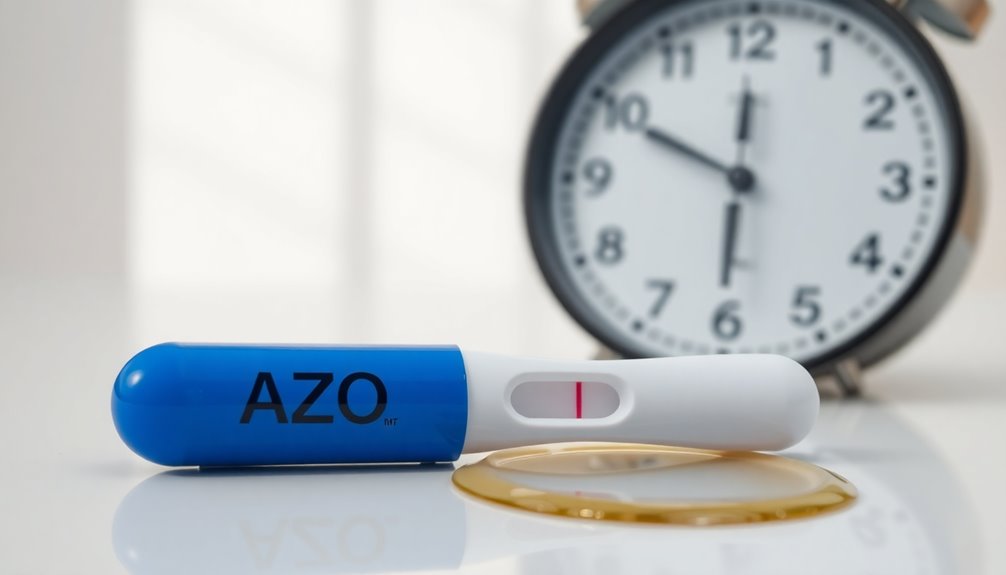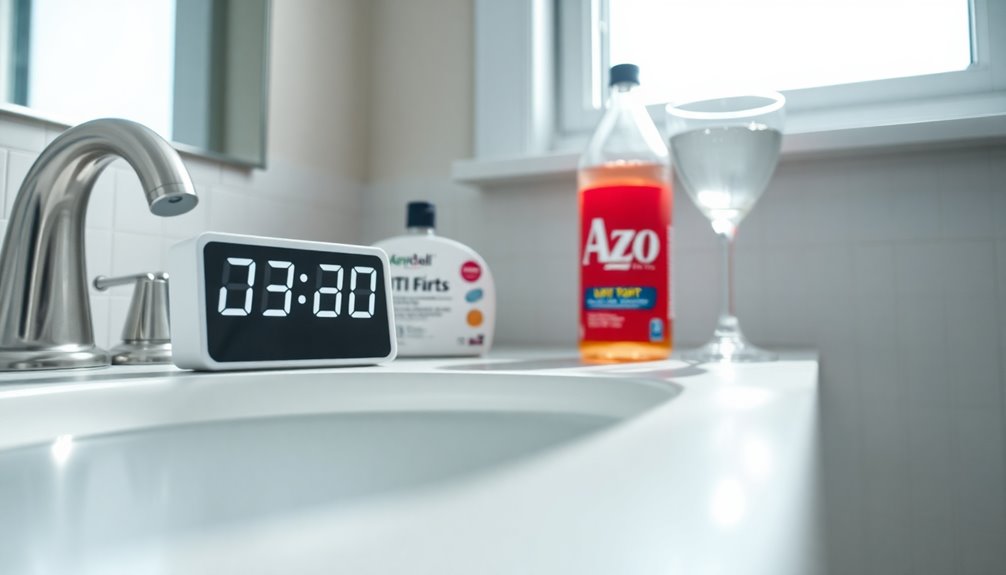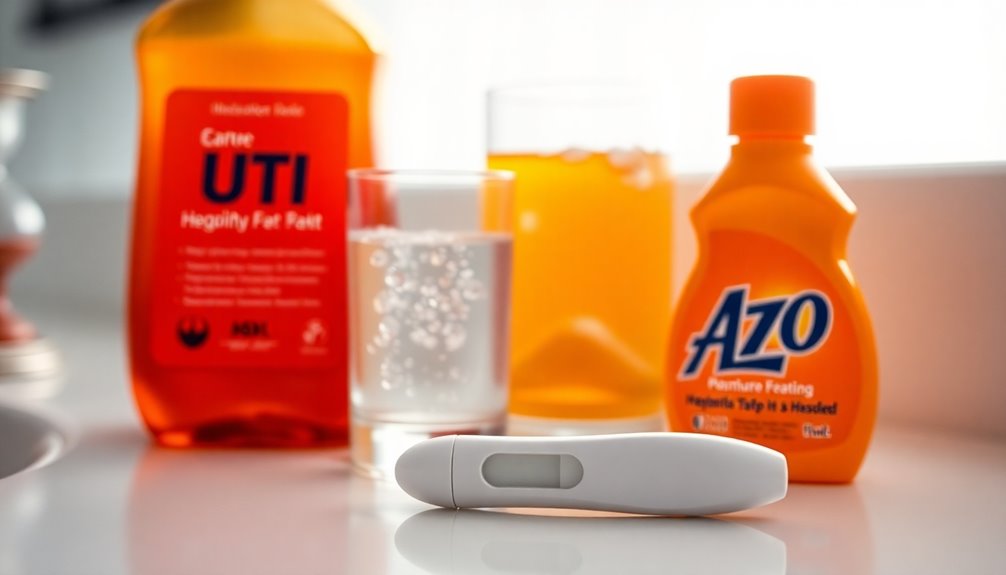If you've taken AZO, it's best to wait at least three days before getting a UTI test. AZO can change your urine's color to orange, which can lead to inaccurate test results, especially with dipstick tests that check for nitrites and leukocyte esterase. After stopping AZO, allow your body some time to clear the medication for reliable results. If immediate testing is necessary, talk to your healthcare provider about alternative pain management options. Understanding the timing can make all the difference in getting an accurate diagnosis, so stay tuned for more helpful information on this topic!
Key Takeaways
- Discontinue AZO (phenazopyridine) at least three days prior to UTI testing for accurate results.
- Wait a minimum of 24 hours after AZO use before testing to avoid false negatives.
- AZO can cause urine discoloration, complicating dipstick test interpretations.
- Consider alternative pain management strategies if immediate testing is necessary.
- Consult healthcare providers for personalized advice on testing timing and management.
Understanding AZO and UTI Tests

When you're dealing with a urinary tract infection (UTI), understanding how medications like AZO can affect test results is crucial. AZO, or phenazopyridine, is known to interfere with certain urine tests, particularly the nitrite test. This medication turns your urine orange, making it harder to read test results accurately. The chemical properties of AZO can even lead to false positive results for nitrite, which can misguide your diagnosis.
Dipstick tests for nitrite and leukocytes are the most impacted, while microscopy and culture tests remain more reliable. However, it's advisable to skip dipstick tests in favor of these comprehensive methods when you're on AZO. Additionally, AZO can skew results for urine sugar and ketone tests, further complicating your situation. To obtain accurate results, healthcare professionals usually recommend stopping AZO for at least three days before testing. It's vital to inform your healthcare provider about your AZO use to ensure they can adjust testing methods accordingly. Quick results from AZO UTI Test Strips can be misleading if taken shortly after using the medication. Failing to disclose this information could lead to misinterpretations and potentially incorrect treatments, complicating your UTI management.
Ideal Timing for Testing

To ensure accurate testing for a urinary tract infection (UTI), timing your tests after taking AZO is essential. It's generally advised that you stop taking AZO at least three days before your urine test. This timeframe allows the medication to clear from your system, minimizing any potential interference with test results, especially if you're having a urine dipstick test.
AZO can cause your urine to appear orange, which might lead to misinterpretation during testing. While it doesn't affect the medical accuracy of UTI tests, the color change can complicate things. If you're experiencing significant discomfort, you might need to explore alternative pain management strategies during this waiting period. Proper timing for UTI test results is critical as reading the results too late can lead to false conclusions.
If immediate testing is necessary, consider asking your healthcare provider about urine cultures or microscopy tests. These methods are less influenced by the color changes caused by AZO and can still provide accurate results.
Always consult your healthcare provider for specific recommendations tailored to your needs, especially if you have frequent UTIs or are unsure about managing your symptoms while waiting for accurate test results.
Impact of AZO on Test Results

Stopping AZO before your UTI test is important, but understanding its impact on test results is equally vital. AZO, or phenazopyridine, can interfere with the leukocyte esterase part of the urine dipstick test, making results less reliable.
While it doesn't affect the nitrate component directly, it can cause a false positive for nitrite due to the color change it induces in your urine. This means that even if a dipstick test shows nitrites, you can't always trust that result if you've been taking AZO.
Because of this interference, clinicians might skip dipstick tests altogether and go straight to urine cultures or microscopy, which remain unaffected by AZO. These tests are crucial for accurately diagnosing a UTI, as they can identify bacteria and white blood cells without the complications that AZO introduces. In fact, 50% of women will have experienced a bladder infection by age 32, highlighting the importance of accurate testing.
Furthermore, false positives can lead to unnecessary anxiety and incorrect treatment decisions. That's why it's critical to inform your healthcare provider if you've been using AZO.
Understanding these impacts helps ensure you receive the most accurate diagnosis and appropriate treatment for your UTI.
Recognizing Key Markers

Recognizing key markers in urine tests is essential for diagnosing a urinary tract infection (UTI). When you undergo testing, you're looking for specific indicators that signal infection, like bacteriuria. The presence of bacteria in your urine, especially at levels of 5+ or 100,000 CFUs/mL, typically suggests a UTI. Even lower counts, such as 2+ or 100 CFUs/mL, can also indicate infection in certain populations.
Another important marker is pyuria, characterized by urine white blood cells (WBC) greater than 10 or a positive leukocyte esterase test. While pyuria suggests inflammation, it's not a definitive sign of infection. If you don't have pyuria, it's unlikely that an infection is present.
Urinary cytokines, like IL-8, can also help. Elevated IL-8 levels are found in 92% of infected individuals, regardless of the bacteria involved. Presence of bacteria in urine indicates potential UTI, which is crucial for accurate diagnosis and treatment.
Finally, urine dipstick tests measure leukocyte esterase and nitrite; however, they've limitations. Microscopic examination of urine can reveal WBC counts and the presence of casts, helping differentiate between upper and lower UTIs.
Understanding these markers will guide you in recognizing a potential UTI effectively.
Post-Antibiotic Testing Guidelines

After understanding the key markers in urine tests for UTIs, it's important to consider how antibiotic treatment impacts follow-up testing. When you've taken antibiotics for a UTI, you need to wait before testing again. This is because antibiotic administration can significantly lower the chances of a positive culture, often leading to false negatives if you test too soon after starting your medication. Research shows that a 7-day antibiotic course can be just as effective as longer treatments, so timing your follow-up test becomes even more critical.
It's best to complete your antibiotic course and then wait a few days before undergoing follow-up testing. This ensures that any lingering infection is accurately assessed. Remember, urinary culture sensitivity drops rapidly—within hours of taking antibiotics—so timing matters.
For the most reliable results, test your urine in the morning after at least four hours without urinating, allowing bacteria to convert nitrates to nitrites effectively.
If your symptoms persist after finishing antibiotics, retesting may be necessary to confirm the infection's resolution. Always consult with your healthcare provider about the best timing for follow-up tests to ensure you're getting the right care and accurate results.
Additional Diagnostic Options

When you're dealing with recurrent UTIs or persistent symptoms, exploring additional diagnostic options is essential for a thorough assessment. A urinalysis and urine culture are often your first steps. They analyze your urine for blood cells and bacteria, helping identify the specific bacteria causing your infection. Just remember to collect a mid-stream sample to avoid contamination, and be aware that Azo can interfere with the results.
If the problem persists, imaging tests like ultrasounds, CT scans, or MRIs can help identify any structural issues in your urinary tract, such as kidney stones. These tests aren't affected by Azo, making them reliable options. Bacteria, primarily Escherichia coli, is the most common cause of UTIs, and identifying it can guide effective treatment.
Cystoscopy is another valuable tool. This procedure allows your doctor to examine the inside of your urethra and bladder directly, identifying abnormalities that may contribute to recurrent infections. Lastly, don't overlook blood tests and physical exams. These can check for more serious infections and assess kidney function, providing a comprehensive understanding of your condition.
Frequently Asked Questions
Can AZO Affect Other Medical Tests Besides UTI Tests?
Yes, AZO can affect other medical tests besides UTI tests.
It can interfere with urine sugar tests, making results difficult to read, and may cause false positives for blood and protein.
It's crucial you inform your healthcare provider about your AZO use before any testing. This way, they can interpret results accurately and avoid misdiagnosis.
How Long Does AZO Stay in the System?
AZO, or phenazopyridine, typically stays in your system for about 12 hours, during which it can change your urine color to orange.
While its effects might linger, it's best to stop using AZO at least 12 hours before any urine test to ensure accurate results.
If you've been using it for symptomatic relief, consider consulting your healthcare provider for specific timing recommendations to avoid any interference with your test outcomes.
Are There Alternative Pain Relievers for UTI Symptoms?
If you're dealing with UTI symptoms, you've got several alternative pain relievers.
Prescription phenazopyridine can be an option, alongside antibiotics for comprehensive relief.
Over-the-counter options, like ibuprofen or acetaminophen, can help manage discomfort too.
Remember, while these medications alleviate pain, they won't treat the infection itself.
It's best to consult your healthcare provider to find the right approach for your symptoms and ensure effective treatment.
What Should I Do if I Accidentally Test While on AZO?
If you accidentally test while on AZO, you should consider re-testing after stopping the medication.
The dye can skew results, leading to false positives. Inform your healthcare provider about your AZO use for accurate interpretation of your test results.
They may recommend a urine culture instead, which isn't affected by AZO.
Monitor your symptoms closely, and if they persist, follow up with your provider for further evaluation.
Can Diet or Hydration Impact UTI Test Results?
Yes, your diet and hydration can significantly impact UTI test results.
Consuming certain foods, like those high in sugar or alcohol, might increase your UTI risk or cause false positives in tests. Staying well-hydrated helps dilute your urine, which can aid in accurate testing.
If you're concerned about your diet's effect on test results, consider discussing it with your healthcare provider for tailored advice and recommendations.
Conclusion
In conclusion, timing is crucial when taking AZO before a UTI test. To get the most accurate results, wait at least 24 hours after your last dose of AZO. This way, you'll avoid any interference with the test. Remember, if you're still unsure or have lingering symptoms, consult your healthcare provider for additional guidance. Staying informed helps you manage your health effectively and ensures you get the right diagnosis when you need it.









